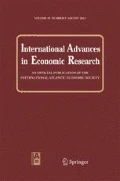Abstract
This paper presents indirect evidence that absolute purchasing power parity (PPP) may hold in the long-run between Mexico and the U.S., but due to data limitations, the relationship could not be tested directly. Thus it is not clear if absolute PPP holds in the long run between the U.S. and Mexico. Given that relative PPP is a necessary, but not sufficient, condition for absolute PPP to hold, this study tests the relationship between the change in the log of the exchange rate, and the changes in the log of the U.S. producer price index (PPI) and the Mexican PPI. Here, the absence of relative PPP would indicate that absolute PPP could not hold. Given that all the relevant variables in first difference log are stationary, PPP in its relative form holds and OLS can be applied directly in a VAR model setting, viz., treating all variables initially as potentially endogenous. The estimates indicate one-way Granger causality from the percentage change in the exchange rate to the percentage change in the Mexican price level, which is not an implausible result for an emerging nation such as Mexico which imports a significant fraction of (dollar denominated) intermediate products and capital inputs.
Similar content being viewed by others
Notes
Using a VECM to initially test for this restriction is a relatively new approach in PPP. Previous literature may not have had access to more modern cointegration techniques or may have just assumed the restriction held so that the model could be written in terms of just two variables, the exchange rate and price ratio. For examples of the assumption of this restriction, see Chen (1995) and Ramirez and Khan (1999).
The ZA test was conducted using Model C and four lags since the data are quarterly. All tests were conducted at the 5 % significance level. Full tests and results (i.e. constant, trend, etc.) are available upon request.
VECM results with two baseline cointegrating vectors are available upon request.
VECM results with one baseline cointegrating vector are available upon request.
References
Banco De Mexico. PPI producer and international trade price indexes. Finished Goods and Services. Retrieved May 2, 2015.
Blecker, R. A. (2003). The north American economies after NAFTA: a critical appraisal. International Journal of Political Economy, 33(3), 5–27.
Chen, B. (1995). Long-run purchasing power parity: evidence from some European monetary system countries. Applied Economics, 27(4), 377–383.
Dolado, J. J., Jenkinson, T., & Sosvilla‐Rivero, S. (1990). Cointegration and unit roots. Journal of Economic Surveys, 4(3), 249–273.
Engle, R.F., & Granger, C.W. (1987). Co-integration and error correction: representation, estimation, and testing. Econometrica: Journal of the Econometric Society, 251–276.
Frankel, J.A. (1985). International capital mobility and crowding out in the US economy: imperfect integration of financial markets or of goods markets? National Bureau of Economic Research.
Glynn, J., Perera, N., & Verma, R. Unit root tests and structural breaks: a survey with applications. Faculty of Commerce-Papers, (2007):455.
Grether, D.M., &Nerlove, M. (1970). Some properties of “optimal” seasonal adjustment. Econometrica: Journal ofthe Econometric Society, 682–703.
Hakkio, C. S. (1992). Is purchasing power parity a useful guide to the dollar? Economic Review-Federal Reserve Bank of Kansas City, 77, 37.
Johansen, S., & Juselius, K. (1990). Maximum likelihood estimation and inference on cointegration—with applications to the demand for money. Oxford Bulletin of Economics and Statistics, 52(2), 169–210.
Kim, Y. (1990). Purchasing power parity in the long run: a cointegration approach. Journal of Money, Credit and Banking, 491–503.
Neely, C.J. (1996). The giant sucking sound: Did NAFTA devour the mexican peso? Federal Reserve Bank of St. Louis Review, 78.
Pantula, S. G. (1989). Testing for unit roots in time series data. Econometric Theory, 5(2), 256–271.
Ramirez, M. D., & Khan, S. (1999). A cointegration analysis of purchasing power parity: 1973–1996. International Advances in Economic Research, 5(3), 369–385.
Randall, L. (1997). The political economy of Latin America in the postwar period. Austin: The University of Texas Press.
Rogoff, K. (1996). The purchasing power parity puzzle. Journal of Economic literature, 647–668.
US. Bureau of Labor Statistics, Producer Price Index by Commodity for Finished Goods [PPIFGS], Retrieved from FRED, Federal Reserve Bank of St. Louis https://research.stlouisfed.org/fred2/series/PPIFGS/, May 2 2015.
US. Bureau of Labor Statistics, Producer Price Index for All Commodities [PPIACO], Retrieved from FRED, Federal Reserve Bank of St. Louis https://research.stlouisfed.org/fred2/series/PPIACO/, May 2 2015.
Yarbrough, B. V., & Yarbrough, R. M. (2006). The world economy: open-economy macroeconomics and finance. Mason: Thomson/South-Western.
Author information
Authors and Affiliations
Corresponding author
Rights and permissions
About this article
Cite this article
Yee, S., Ramirez, M.D. Purchasing Power Parity: A Time Series Analysis of the U.S. and Mexico, 1995–2007. Int Adv Econ Res 22, 409–419 (2016). https://doi.org/10.1007/s11294-016-9598-4
Published:
Issue Date:
DOI: https://doi.org/10.1007/s11294-016-9598-4
Keywords
- Absolute PPP
- Granger block causality test
- Johansen cointegration test
- KPSS unit root test
- Mexico
- Pantula Principle
- Relative PPP
- Vector autoregressive model (VAR)
- Zivot-Andrews single-break unit root




